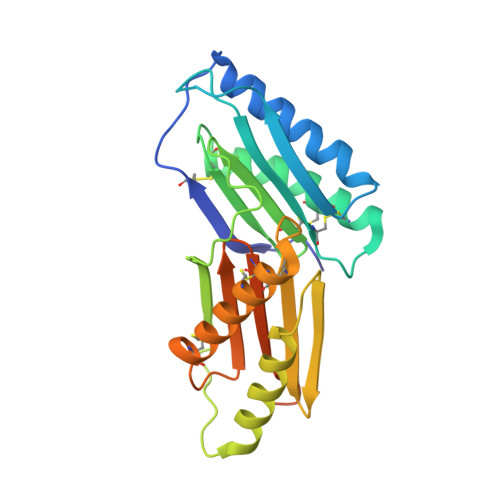Mechanistic insights into the evolution of DUF26-containing proteins in land plants.
Vaattovaara, A., Brandt, B., Rajaraman, S., Safronov, O., Veidenberg, A., Luklova, M., Kangasjarvi, J., Loytynoja, A., Hothorn, M., Salojarvi, J., Wrzaczek, M.(2019) Commun Biol 2: 56-56
- PubMed: 30775457
- DOI: https://doi.org/10.1038/s42003-019-0306-9
- Primary Citation of Related Structures:
6GRE, 6GRF - PubMed Abstract:
Large protein families are a prominent feature of plant genomes and their size variation is a key element for adaptation. However, gene and genome duplications pose difficulties for functional characterization and translational research. Here we infer the evolutionary history of the DOMAIN OF UNKNOWN FUNCTION (DUF) 26-containing proteins. The DUF26 emerged in secreted proteins. Domain duplications and rearrangements led to the appearance of CYSTEINE-RICH RECEPTOR-LIKE PROTEIN KINASES (CRKs) and PLASMODESMATA-LOCALIZED PROTEINS (PDLPs). The DUF26 is land plant-specific but structural analyses of PDLP ectodomains revealed strong similarity to fungal lectins and thus may constitute a group of plant carbohydrate-binding proteins. CRKs expanded through tandem duplications and preferential retention of duplicates following whole genome duplications, whereas PDLPs evolved according to the dosage balance hypothesis. We propose that new gene families mainly expand through small-scale duplications, while fractionation and genetic drift after whole genome multiplications drive families towards dosage balance.
Organizational Affiliation:
1Organismal and Evolutionary Biology Research Programme, Viikki Plant Science Centre, VIPS, Faculty of Biological and Environmental Sciences, University of Helsinki, Viikinkaari 1 (POB65), FI-00014 Helsinki, Finland.















